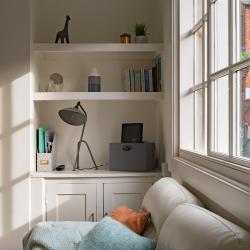Creating a DIY Home Office Space
In an era where remote work has become the norm, creating a functional and inspiring home office has never been more important. Whether you're a freelancer, a corporate employee working from home, or a student attending virtual classes, a well-designed office space can boost productivity, creativity, and comfort. Here’s a step-by-step guide to help you transform a part of your home into an efficient office, tailored to your personal style and needs.
Step 1: Identify the Right Location
The first step in creating a DIY home office is selecting the ideal spot within your home. Consider spaces that:
- Minimize Distractions: Select a location away from high-traffic areas like the kitchen or living room.
- Maximize Natural Light: A spot by a window can enhance mood and productivity.
- Ensure Good Acoustics: Consider an area where noise can be controlled or minimized.
If space is limited, consider innovative solutions like converting a closet into a "cloffice" or using room dividers to create a designated area in a larger room.
Step 2: Choose the Right Furniture
Investing in the right furniture is crucial for comfort and efficiency. Key pieces include:
- Desk: Opt for a desk that suits your working needs. Compact designs work well for small spaces, while L-shaped desks offer ample surface area.
- Chair: A comfortable, ergonomic chair is essential to prevent back strain during long working hours.
- Storage Solutions: Use shelves, filing cabinets, or desk organizers to keep clutter at bay and important documents within reach.
For those on a budget, consider upcycling furniture or exploring second-hand stores for unique finds.
Step 3: Consider Ergonomics
Ergonomics play a critical role in creating a healthy and sustainable work environment. To optimize your setup:
- Monitor Height: Adjust your monitor so that the top is at or slightly below eye level.
- Keyboard and Mouse Positioning: Keep your wrists straight and your hands at or slightly below elbow level.
- Chair Height: Your feet should be flat on the floor, or on a footrest, with your knees at a 90-degree angle.
Step 4: Personalize Your Space
A personalized workspace can improve motivation and job satisfaction. To make the space your own:
- Decorate: Add art, plants, or photographs that inspire you.
- Color Scheme: Choose colors that promote focus and calm, such as blues, greens, or neutrals.
- Lighting: Soft, warm lighting is ideal to reduce eye strain. Consider task lighting for detailed work.
Step 5: Manage Technology and Connectivity
A modern office requires robust technological support. Ensure:
- Reliable Internet Access: Position your desk near a router or use a Wi-Fi extender for a strong connection.
- Cable Management: Use clips, ties, or channels to keep cords organized and out of sight.
- Equipment Setup: Ensure your computer, printer, and other devices are set up for efficient use.
Step 6: Maintain a Tidy and Organized Environment
A clutter-free workspace promotes productivity and reduces stress. Implement measures to stay organized:
- Weekly Clean-Up: Dedicate time weekly to tidy up your workspace.
- Effective Filing System: Keep digital and physical files organized. Use cloud storage for easy access and security.
Conclusion
Creating a DIY home office is more than just placing a desk and a chair. It involves thoughtful planning, personalization, and organization to ensure the space meets both functional and emotional needs. Whether you have a spacious room or a small corner, a well-designed office can enhance your work-from-home experience, cultivate creativity, and improve productivity. With these steps, you can build an office space that reflects your style and helps you thrive professionally in the comfort of your own home.






















